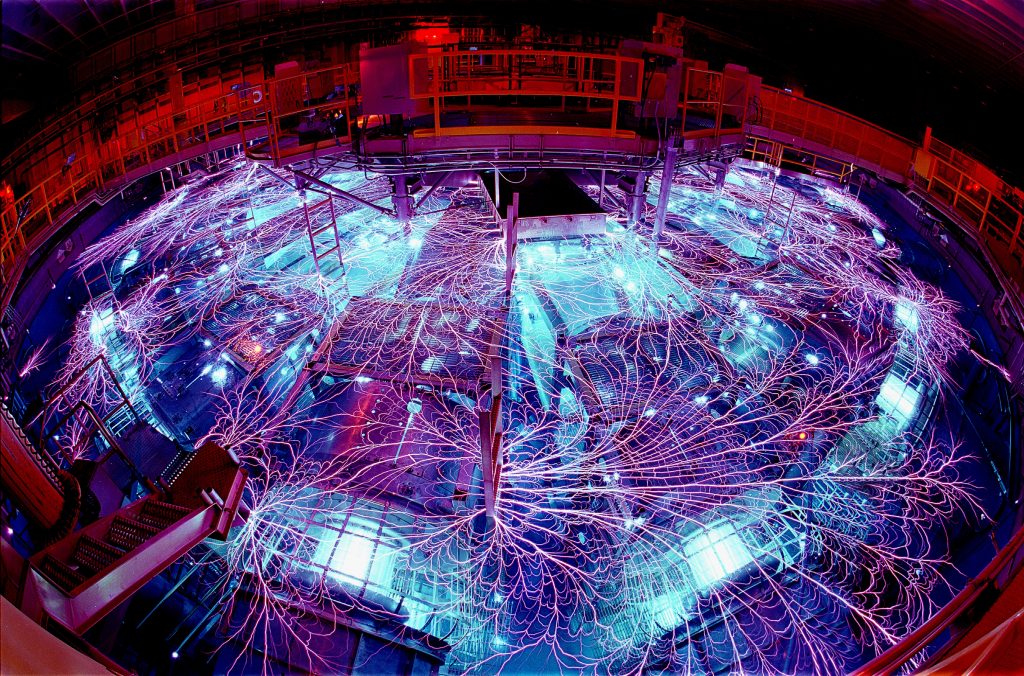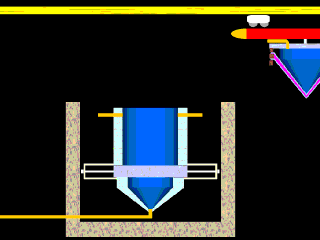
ALBUQUERQUE, NM — A simple theoretical concept to solve the staggeringly difficult problem of maintaining intact electrical transmission lines to produce rapidly repeated thermonuclear explosions for peacetime purposes has been proposed by researchers at the Department of Energy’s Sandia National Laboratories.
The method is meant to advance the day of relatively cheap, clean, fusion-produced energy through machines like Sandia’s Z accelerator.
The concept was presented informally by Sandia researcher Mark Derzon in late July to researchers in Snowmass, Colo., at the first extended meeting of fusion researchers both inertial and magnetic.
There, scientists interested by the concept placed Z pinches on the list for recommended scientific exploration as an energy source.
The Z-pinch accelerator at Sandia, known simply as Z, is far and away the world’s most powerful laboratory X-ray source. However, funding to date for Z has been related to its weapons-program usefulness.
“Getting Z listed as a potential source of energy is a major leap forward for the Z fusion program,” says Tom Hunter, Sandia Senior VP for the nuclear weapons program. “This may be an opportunity to make a significant contribution to our nation’s energy security.”
While weapons research requires only a single explosion to produce data, fusion meant to create virtually unlimited electrical power requires the high-yield implosion of a pea-sized deuterium-tritium pellet every few seconds, says Craig Olson, who organized the inertial fusion section of the Snowmass meeting.

Download 300dpi JPEG image, ‘ Z.jpg’, 2.4Mb (Media are welcome to download/publish this image with related news stories.)
The proposed power generation process for inertial fusion resembles the rapid series of explosions that drive a gasoline engine. Instead of gasoline and air interacting chemically, isotopes of hydrogen fuse. The problem has been that the power of a high-yield thermonuclear explosion would damage not only the pellet-target, which could be rapidly replaced, but also the last five feet of power lines connected to the target. This has been a stumbling block in envisioning Z as a source of real-world power, since a near-continuous stream of rapid-fire explosions is necessary to continuously create steam to turn turbines, says Derzon, who with principal collaborators Gary Rochau, Greg Rochau and Steve Slutz came up with the new concept. Antonio Zamora, manufacturing liaison, provided the cost estimate for the recyclable transmission lines that suggests the concept is feasible.
“The problem has always been how to separate power supply from the physical target,” says Derzon. “We propose to get around the problem by using recyclable transmission lines, perhaps of lithium or flibe [fluorine, lithium, and beryllium].” Hollow spheres — “Christmas tree” ornaments — of lithium or flibe surrounding the lines would serve as the heat exchange medium and moderators of neutron flux.
Transmission lines would cycle on a large horizontal carousel. After the firing, or shot, the then-liquefied lithium or flibe would be pushed out of the chamber and its heat used to drive electrical generators. Tritium, an isotope of hydrogen essential for the fusion process, would be harvested from the liquefied metal. Finally, the spent metal would be put in a mold to form new transmission lines and new “Christmas tree” ornaments.
Rather than trying to create a vacuum in the entire chamber after each shot, Derzon’s group, consulting with Olson and Rick Spielman , proposes to pump only the space between recyclable transmission lines — a much quicker, cheaper, and easier procedure than emptying the whole chamber.
“Now it’s just a concept. At Snowmass, they were very receptive and we hope to get resources to do a design study,” says Derzon.
Nuclear fusion could be a way to produce energy not only on Earth but also in spacecraft or in space colonies, since its power source — isotopes of hydrogen — for the most part is readily available.

The carousel “feed” on the upper right contains power transmission lines (violet) and a Z-pinch target (invisible because so tiny). When moved into place, tinsel-type ornaments (green) are blown into place. At the fusion flash, transmission lines and ornaments melt. The bottom of the chamber opens and a piston pushes out the melted material. Neutrons captured by the material will be used for tritium generation. Heat will be used to produce steam for turbine power generation. The next limb of the carousel slides into place and the process repeats.
For more information:
- Z, which reaches temperatures of the Sun, to help astronomers interpret Chandra data (November 5, 1999)
- Concept for rapid-fire thermonuclear explosions proposed by Sandia scientists (September 13, 1999)
- Sandia researchers push Z machine to new limits to test radiation effects (June 16, 1999)
- Sandia formally proposes to design accelerator expected to produce high-yield fusion (April 8, 1998)
- Another dramatic climb toward fusion conditions for Sandia Z accelerator (March 2, 1998)
- Output of Sandia Z Accelerator Climbs Closer to Fusion (August 1, 1997)
- High-Output Sandia Accelerator Able to Predict Nuclear Blast Physics (December 2, 1996)